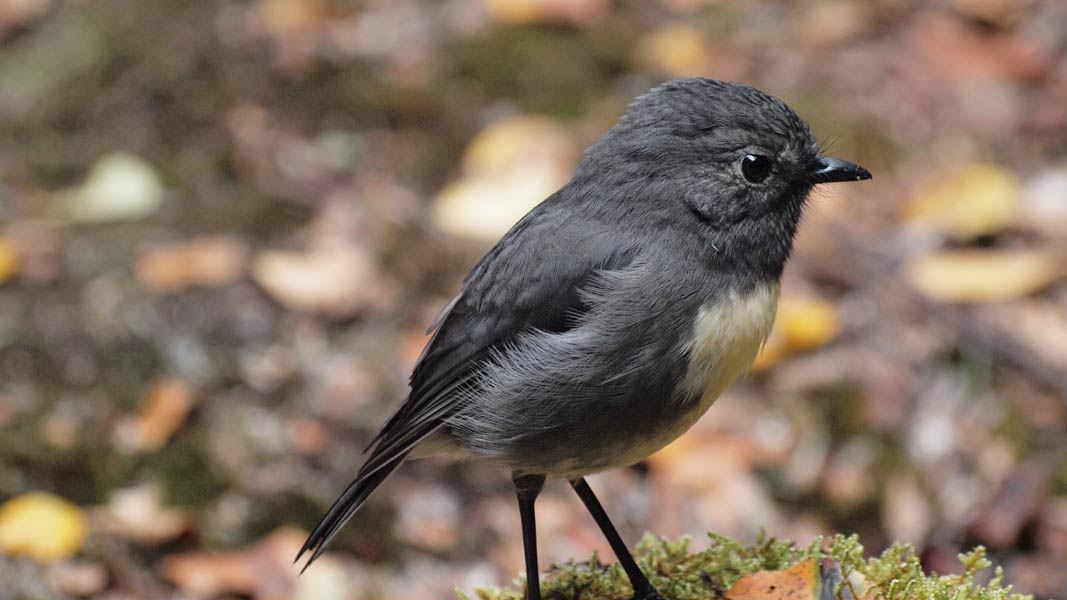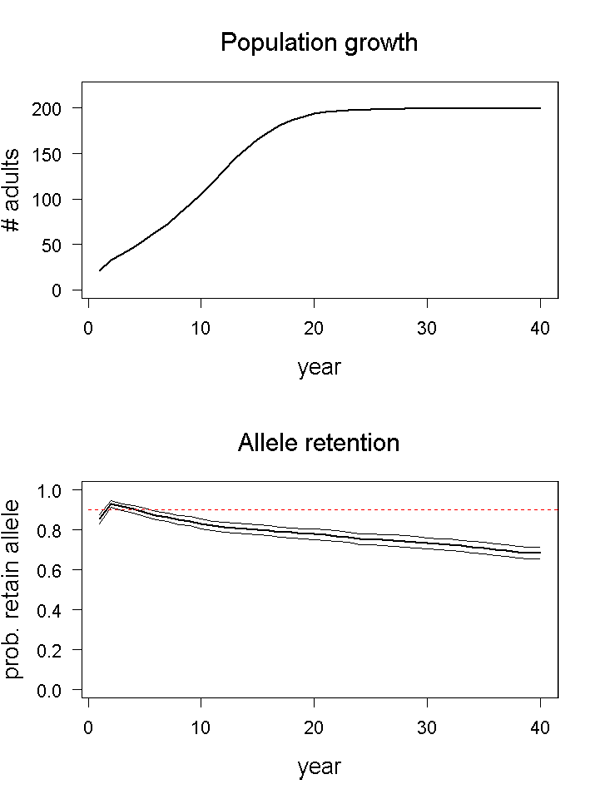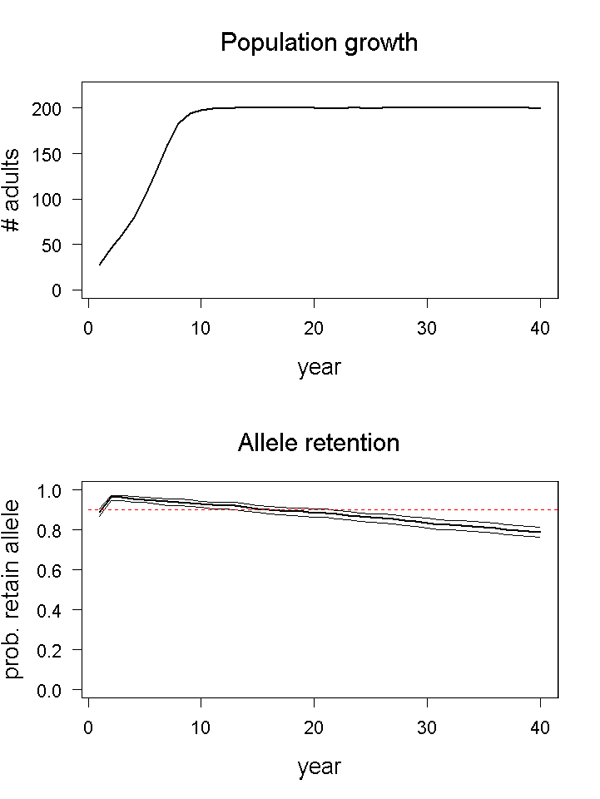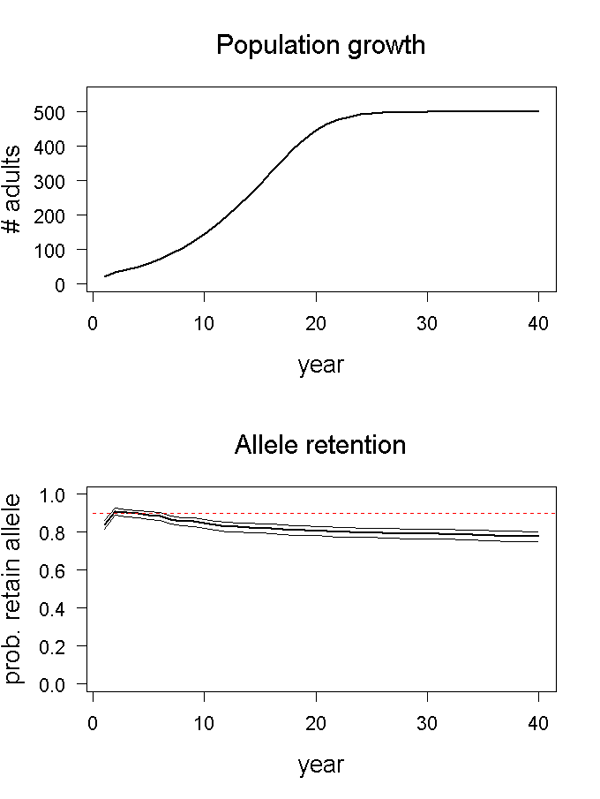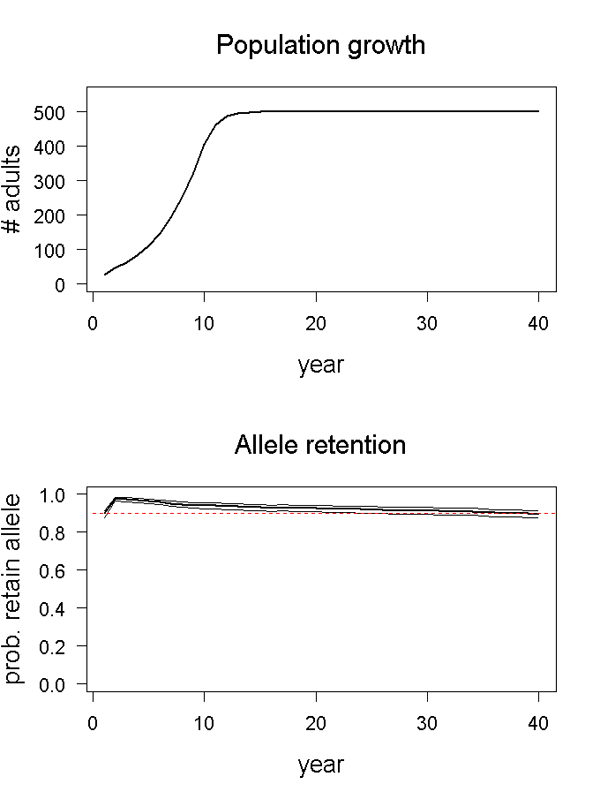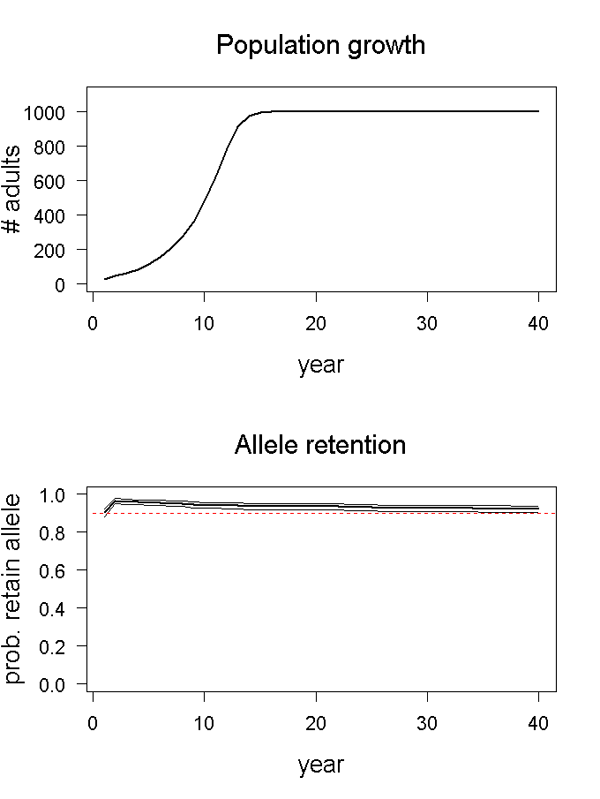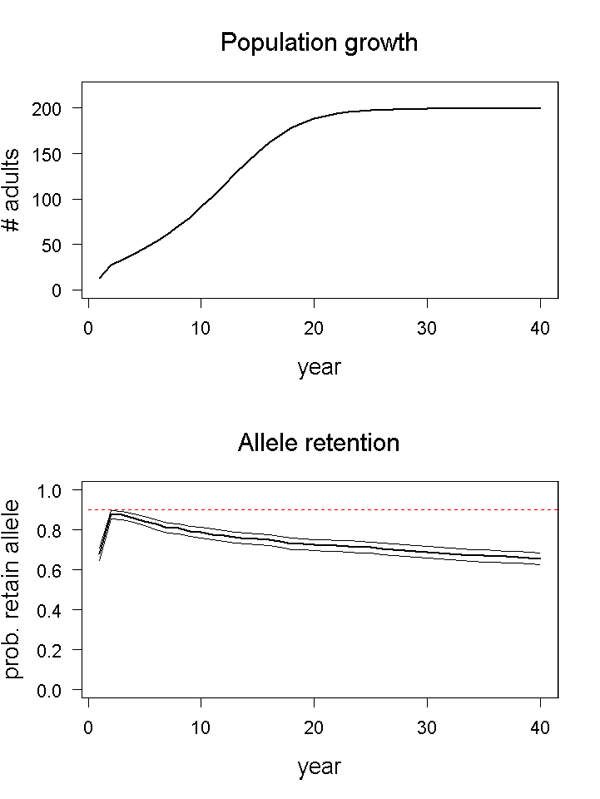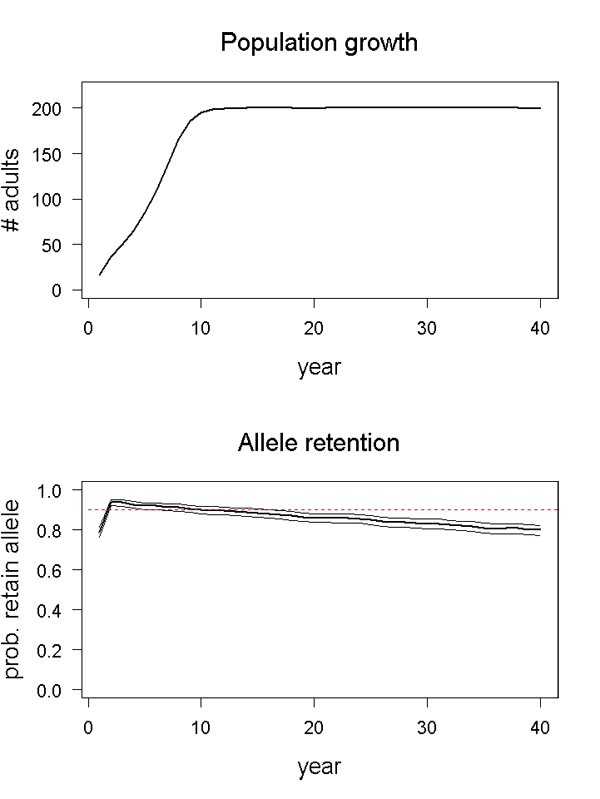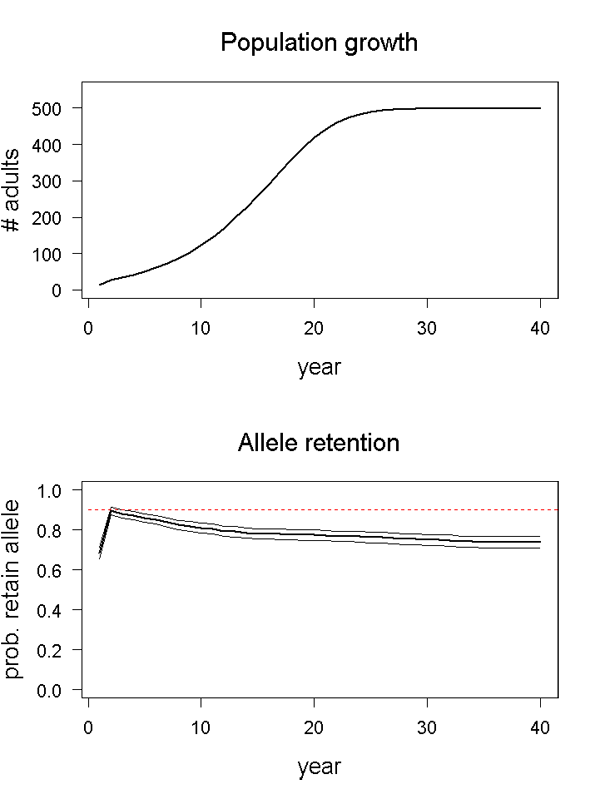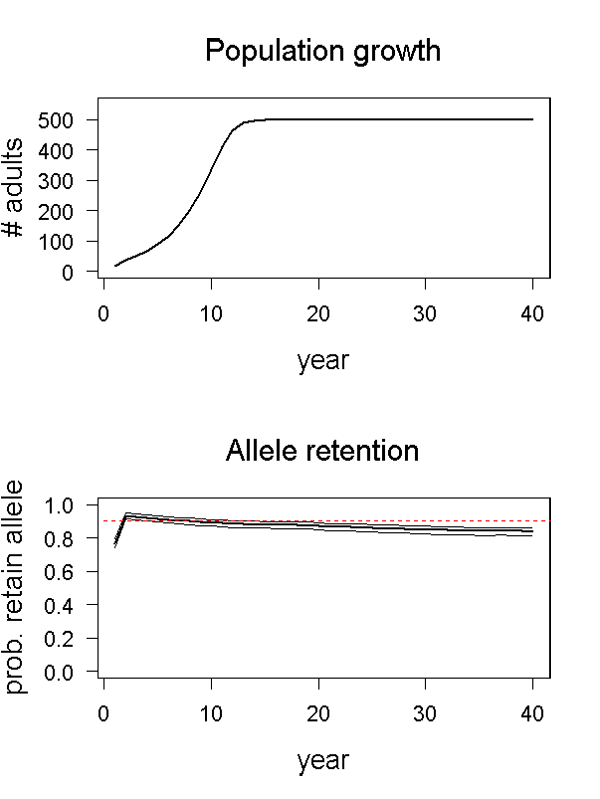First determine your habitat connectivity, habitat size and predator control levels of the translocation site; then view the predicted success of translocations for different scenarios.
Points to note if you are translocating one of these taxa
There have been few mainland translocations of South Island and Stewart Island robins.
These robins prefer mature forest, scrub and exotic plantations, and favour an open understorey under a closed canopy with moist, fertile soils.
Data for North Island robins were sometimes used in these projections because very little information is available for South Island or Stewart Island robins.
For North Island robins, there has been greater success when the destination site has similar (or fewer) predator types to the source site because some populations become naive to predators (e.g. islands to islands rather than islands to unfenced mainland sites). This will likely also be the case for South Island and Stewart Island robins.
The data for these taxa were obtained from productive mainland populations and so the projections are optimistic.
It is usually preferable to undertake a single translocation but translocations are sometimes undertaken in two or more consecutive years. There is some evidence that follow-up translocations are less successful but this is likely to vary between sites – for example, if your release site is large, there will be plenty of space for any birds that are released in follow-up translocations to avoid resident birds from the first translocation and establish their own territories; however, if your release site is small, any birds that are released in follow-up translocations will be more likely to encounter resident birds, which could make them more prone to dispersal or stress-related mortality.
You can find further information in Best practice techniques for the translocation of North Island robins (Petroica longipes), South Island robins (P. australis australis) and Stewart Island robins (P. a. rakiura).
Factors of success for South Island and Stewart Island robins
Founder number for maximising genetic diversity
60–80 in a single translocation; or 40 + 40 at medium- and high-connectivity sites, and 30 + 30 at low-connectivity sites
Habitat connectivity
Low (isolated)
Dispersal is likely to be low at sites with low connectivity. It is unclear how big the gap needs to be to prevent South Island robins from dispersing to surrounding habitats, but translocated Stewart Island robins have been known to cross water gaps ≥ 800 m.
Medium
The behaviour of birds in medium-connectivity sites is unknown but may be similar to that of North Island robins. where translocations to sites with medium connectivity have been successful (e.g. Tawharanui Regional Park), although juvenile dispersal from some sites has been high.
High (adjoining)
Dispersal is likely to be high in adjoining habitats. For instance, there has been significant post-translocation dispersal of adults following translocation to Ulva Island, with some birds moving ≥ 20 km, including flying over ≥ 800 m of open water.
Habitat size
The following values refer to island sites. South Island robin densities at protected sites on the mainland are not currently known but will likely be less than on islands. Therefore, more habitat will likely be required for the same number of birds at a mainland site.
Small (minimum area)
< 100 ha
Medium
c. 135 ha
Large
≥ c. 300 ha
Minimum predator control
If you are translocating South Island or Stewart Island robins, you will need to maintain predators at a low density at the release site at a minimum. However, the overall survival and productivity of the translocated population will probably be higher at sites where predators are eradicated or maintained at zero density.
Predators maintained at low density
It is currently unclear what level of predator control is required for South Island/Stewart Island robin translocations. However, the findings of other research on these taxa indicate that rat control is essential over the breeding season to ensure female survival and successful population establishment, with a recommendation of < 5% tracking tunnel indices during this time. Mustelid and cat control is also recommended.
Predators eradicated
This requires the total eradication of all target predators with the exception (in most cases) of mice, or the maintenance of zero density year-round.
Predicted success for scenarios
South Island and Stewart Island robins: Scenario 1
Scenario: Low habitat connectivity, small habitat size, predators maintained at low density.
Data source: Few data are available for mainland populations of South Island robins. Therefore, this projection used island productivity and survival data, with initial survival increased to 0.9 and reduced juvenile survival based on mainland North Island robin data.
Conditions: 40 birds were translocated in year one followed by a further 20 in year two; the carrying capacity of the site was 200 robins; there was no migration.
Outcome: A viable population will likely establish slowly, but some genetic diversity will be lost over ten generations, which could affect the long-term persistence of the population. You could improve this result by increasing the amount of predator control or translocating individuals to a larger site (see scenarios 2 and 6, respectively).
South Island and Stewart Island robins: Scenario 2
Scenario: Low habitat connectivity, small habitat size, predators eradicated.
Data source: Few data are available for mainland populations of South Island robins. Therefore, this projection used island productivity and survival data, with initial survival increased to 0.9 based on North Island robin data.
Conditions: 40 birds were translocated in year one followed by a further 20 in year two; the carrying capacity of the site was 200 robins; there was no migration.
Outcome: A viable population will likely establish and c. 80% of genetic diversity will be maintained over ten generations. Predator eradication reduces the time required for the population to establish and improves the genetic diversity compared with Scenario 1.
South Island and Stewart Island robins: Scenario 3
Scenario: Low habitat connectivity, medium habitat size, predators maintained at low density.
Data source: Few mainland South Island robin data are available. Therefore, this projection used island productivity and survival data, with initial survival increased to 0.9 and reduced juvenile survival based on mainland North Island robin data.
Conditions: 40 birds were translocated in year one followed by a further 20 in year two; the carrying capacity of the site was 500 robins; there was no migration.
Outcome: A viable population will likely establish, but population growth will be slow due to the reduced survival of juveniles. Some genetic diversity will be lost over ten generations but this will be close to 80%. You could improve this result by increasing the level of predator control (see Scenario 4).
South Island and Stewart Island robins: Scenario 4
Scenario: Low habitat connectivity, medium habitat size, predators eradicated.
Data source: Few data are available for mainland populations of South Island robins. Therefore, this projection used island productivity and survival data, with initial survival increased to 0.9 based on North Island robin data.
Conditions: 40 birds were translocated in year one followed by a further 20 in year two; the carrying capacity of the site was 500 robins; there was no migration.
Outcome: A viable population will likely establish and 80–90% of genetic diversity will be maintained over ten generations.
South Island and Stewart Island robins: Scenario 5
Scenario: Low habitat connectivity, large habitat size, predators maintained at low density.
Data source: Few mainland South Island robin data are available. Therefore, this projection used island productivity and survival data, with initial survival increased to 0.9 and reduced juvenile survival based on mainland North Island robin data.
Conditions: 40 birds were translocated in year one followed by a further 40 in year two; the carrying capacity of the site was 1000 robins; there was no migration.
Outcome: A viable population will likely establish slowly and 90% of genetic diversity will be maintained over ten generations.
South Island and Stewart Island robins: Scenario 6
Scenario: Low habitat connectivity, large habitat size, predators eradicated.
Data source: Few data are available for mainland populations of South Island robins. Therefore, this projection used island productivity and survival data, with initial survival increased to 0.9 and reduced juvenile survival based on mainland North Island robin data.
Conditions: 40 birds were translocated in year one followed by a further 20 in year two; the carrying capacity of the site was 1000 robins; there was no migration.
Outcome: A viable population will likely establish and > 90% of genetic diversity will be maintained over ten generations. This improved outcome results from the protected area being large and isolated, and predators being eradicated.
South Island and Stewart Island robins: Scenario 7
Scenario: Medium habitat connectivity, small habitat size, predators maintained at low density.
Data source: Few mainland South Island robin data are available. Therefore, this projection used island productivity and survival data, with low initial survival due to dispersal (this may be higher at less connected sites) and reduced juvenile survival based on mainland North Island robin data.
Conditions: 40 birds were translocated in year one followed by a further 40 in year two; the carrying capacity of the site was 200 robins; there was no migration.
Outcome: A viable population will likely establish slowly due to the initial dispersal, and dispersal and the small habitat size will lead to some loss of genetic diversity over ten generations, which could affect the long-term persistence of the population. You could improve this outcome by eradicating predators (see Scenario 8) or choosing a larger site (see Scenarios 9 and 10).
South Island and Stewart Island robins: Scenario 8
Scenario: Medium habitat connectivity, small habitat size, predators eradicated.
Data source: Few data are available for mainland populations of South Island robins. Therefore, this projection used island productivity and survival data, with low initial survival due to dispersal (this may be higher at less connected sites) and reduced juvenile survival.
Conditions: 40 birds were translocated in year one followed by a further 40 in year two; the carrying capacity of the site was 200 robins; there was no migration.
Outcome: A viable population will likely establish. This improvement on Scenario 7 results from the eradication of predators leading in faster population growth and genetic diversity.
South Island and Stewart Island robins: Scenario 9
Scenario: Medium habitat connectivity, medium habitat size, predators maintained at low density.
Data source: Few mainland South Island robin data are available. Therefore, this projection used island productivity and survival data, with low initial survival due to dispersal (this may be higher at less connected sites) and reduced juvenile survival based on mainland North Island robin data.
Conditions: 40 birds were translocated in year one followed by a further 40 in year two; the carrying capacity of the site was 500 robins; there was no migration.
Outcome: A viable population will likely establish slowly due to initial dispersal/predation, and some genetic diversity will be lost over ten generations. You could improve this result by eradicating predators (see Scenario 10) or choosing a low-connectivity site (see Scenario 3).
South Island and Stewart Island robins: Scenario 10
Scenario: Medium habitat connectivity, medium habitat size, predators eradicated.
Data source: Few data are available for mainland populations of South Island robins. Therefore, this projection used island productivity and survival data, with low initial survival due to dispersal (this may be higher at less connected sites).
Conditions: 40 birds were translocated in year one followed by a further 40 in year two; the carrying capacity of the site was 500 robins; there was no migration.
Outcome: Although initial survival is low due to dispersal a viable population will likely establish and 80–90% of genetic diversity will be maintained over ten generations.
South Island and Stewart Island robins: Scenario 11
Scenario: High habitat connectivity, large habitat size, predators maintained at low density.
Data source: Few South Island robin data are available. Therefore, this projection used island productivity data, with low initial survival due to dispersal (this may be higher at less connected sites) and reduced juvenile survival based on mainland North Island robin data.
Conditions: The projection outcomes were the same regardless of the number of founders; the carrying capacity of the site was 1000 robins; there was no migration.
Outcome: EXTINCTION. A population will not establish due to the low initial survival and subsequent high juvenile dispersal. No graphs are provided for this scenario because there is high uncertainty – this type of translocation has never been carried out so this projection used a mix of data sources. Therefore, any translocation using this scenario would require a high level of monitoring. You could improve this result by choosing a low-connectivity site (see Scenarios 2–6).
South Island and Stewart Island robins: Scenario 12
Scenario: High habitat connectivity, large habitat size, predators eradicated.
Data source: Few mainland South Island robin data are available. Therefore, this projection used island productivity and survival data, with low initial survival due to dispersal (this may be higher at less connected sites) and reduced juvenile survival based on mainland North Island robin data.
Conditions: The projection outcomes were the same regardless of the number of founders; the carrying capacity of the site was 1000 robins; there was no migration.
Outcome: EXTINCTION. A population will not establish due to the low initial survival and subsequent high juvenile dispersal. No graphs are provided for this scenario because there is high uncertainty – this type of translocation has never been carried out so this projection used a mix of data sources. Therefore, any translocation using this scenario would require a high level of monitoring. You could improve this result by choosing a low connectivity site (see Scenarios 2–6).
